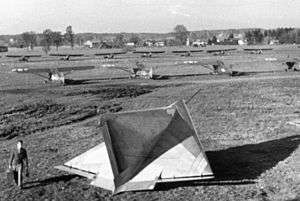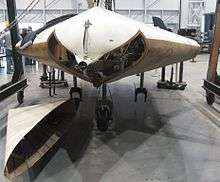Akaflieg Darmstadt/Akaflieg München DM1
The Akaflieg Darmstadt/Akaflieg München DM1, also called the Lippisch DM-1, was a single-seat research glider that was designed and built in Germany from 1944.[1]
| DM1 | |
|---|---|
 | |
| The DM 1 at Munich Prien airport after the war | |
| Role | Full-scale research glider |
| National origin | Germany |
| Manufacturer | Akaflieg Darmstadt & Akaflieg München |
| Designer | Alexander Lippisch |
| First flight | 1944 |
| Number built | 1 |
| Developed into | Lippisch P.13a |
Development
During World War II, Dr. Alexander Lippisch proposed a ramjet propelled point defence fighter Lippisch P.13a. To investigate the low speed handling and aerodynamics of this delta-winged fighter, Lippisch arranged for Akaflieg Darmstadt to build a full-scale flying glider model, which emerged as the Darmstadt D-33. After the Akaflieg Darmstadt workshop was bombed in September 1944, the D-33 project was moved to the Akaflieg München workshops at Prien am Chiemsee. At Prien, Wolfgang Heinemann and Hans Zacher from Darmstadt, with Klaus Metzner and Hermann Nenninger from Munich, completed the D-33 as the Akaflieg Darmstadt/Akaflieg München DM1.
Film footage exists which shows a gliding test of the aircraft. These tests began in May 1944 at Spitzerberg, near Vienna.[2]
The DM1 was built as a single-seat glider from steel-tubing, plywood and bakelite impregnated plywood, with a cockpit in the extreme nose of the junction of the triangular mainplanes and fin. Launching the DM1 was to be by piggy-back or aero-tow.
After occupation by U.S. Troops in May 1945, work continued at the DM1 on behalf of the U.S. military government, with General Patton and Charles Lindbergh visiting Prien to see the project. Completed in early November 1945, the DM1 was shipped in a wooden box to Langley Field in Virginia where the flow behaviour of the DM1 was examined in the NACA (National Advisory Committee for Aeronautics, forerunner of today's NASA) full-size wind tunnel.
While at Langley, the DM1 underwent significant changes. The original design used airfoils of very thick section, especially the vertical stabilizer, which ran all the way to the nose of the aircraft and served double duty as the cockpit. For high speed flight, thicker airfoils are known to have very high drag, which proved to be true on the DM1. The design was progressively modified in an effort to lower drag. One of the first changes was to remove the large vertical stabilizer and replace it with one of much smaller size in a more conventional layout, and adding a normal cockpit canopy taken from a Lockheed P-80 Shooting Star.[3] Further work introduced sharp extensions along the leading edge of the wing, which had the side-effect of showing periodic generation of very large vortexes over the wing.[4] The significance of this effect would not be fully understood until the 1950s.

The DM1 influenced design of the Convair delta fighters such as XP-92, XF-92A, XFY, F2Y, F-102 and F-106. After completion of testing the DM1 was retired to the National Air and Space Museum, Smithsonian Institution in Washington, D.C. for storage at the Paul E. Garber Preservation, Restoration, and Storage Facility.
Akaflieg Darmstadt/Akaflieg München DM1 image gallery
- Model of a DM1
 The DM-1 crated for transport to the US
The DM-1 crated for transport to the US The DM-1 modified for wind tunnel testing at a NACA facility, with sharp leading edges and the canopy from a P-80.
The DM-1 modified for wind tunnel testing at a NACA facility, with sharp leading edges and the canopy from a P-80. A rear view of the DM-1 awaiting preparation for transport to NACA in the US.
A rear view of the DM-1 awaiting preparation for transport to NACA in the US.
Specifications (DM1)
Data from DM1 bis DM4[1]
General characteristics
- Crew: 1
- Length: 6.32 m (20 ft 9 in)
- Wingspan: 6 m (19 ft 8 in)
- Height: 3.25 m (10 ft 8 in)
- Wing area: 19 m2 (200 sq ft) ca
- Empty weight: 375 kg (827 lb)
- Gross weight: 460 kg (1,014 lb)
Performance
- Maximum glide ratio: 7
See also
Related development
Aircraft of comparable role, configuration and era
- Convair XP-92
- Payen Pa 49
References
- "DM1 bis DM4". Archived from the original on 2014-07-14. Retrieved 2014-07-01.
- "Experiments with delta wing models of small aspect ratios (circa 1944)" (YouTube video). youtube.
- "Research Memorandum L7F16", NACA, 5 August 1947
- "Investigation of the DM-1 Glider", NACA Langley, 1 August 1946
External links
| Wikimedia Commons has media related to Akaflieg Darmstadt München DM-1. |
- Luft '46 entry on the P.13a, which includes images of the DM-1
- Akaflieg Darmstadt website
- Lippisch DM 1 Reconsidered, Smithsonian NASM